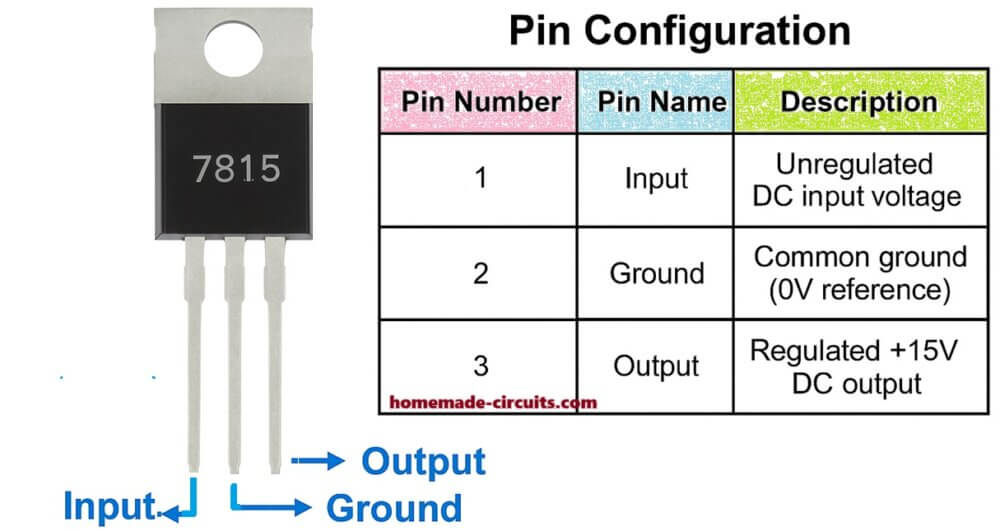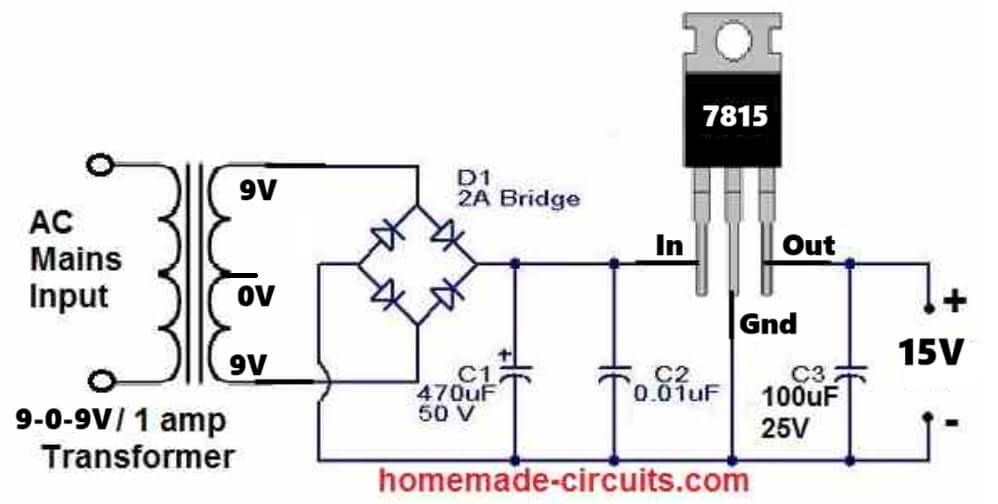In this post I am going to talk about this very common but very useful voltage regulator IC, that is called IC 7815. This chip is from the famous 78XX series of fixed voltage regulators. So the “15” in this number means this IC will always try to give +15V DC output, no matter what input DC we feed, as long as it is higher than 15V.
What is 7815 IC?
IC 7815 is a positive voltage regulator. It gives fixed +15 volts at output. This IC has 3 pins: Input, Ground, Output.
So just we give unregulated high DC voltage at the input pin, connect the center pin to ground, and take out +15V from the output pin.
Very simple to use, no complications. This IC automatically keeps output voltage stable even if input voltage is changing or load is increasing or decreasing.
Basic Features of 7815 IC
Here are some important features of this IC:
- Output voltage = +15V fixed
- Output current = up to 1 ampere normally
- Input voltage range = 17V to 30V DC (minimum input should be at least 2V more than 15V)
- Built-in short-circuit protection
- Built-in thermal shutdown (if it gets too hot, it shuts down)
- Built-in overload protection
- No need of external components for basic working
- So it is very reliable and rugged IC, we can use it without tension.
Pinout of IC 7815
Now let us see the pin details. This IC has 3 pins:


So left pin is the input, center is the ground, right pin is the output.
How to Use 7815 IC?
Very simple it is. Just connect like this:
- Give DC input (like 18V or 24V) at pin 1
- Connect pin 2 to ground
- Take regulated 15V from pin 3

So we must use capacitors at input and output for stability and filtering. Normally 1000uF at input and 100uF at output is ok.
Input Voltage Tips
7815 needs minimum 17V DC input to work properly because it has dropout voltage around 2V. If input drops below 17V then output will not be 15V, it will become less.
Maximum safe input is 35V, but better we keep it under 30V to avoid heating.
Heat and Heatsink Issue
If the input voltage is too high and output current is heavy then this IC will heat up fast. Because it works in linear mode so it drops voltage and converts extra voltage into heat.
For example if you give 24V input and take 1 amp output at 15V:
Power Dissipation = (24 - 15) * 1 = 9 Watts — this much heat it will generate!
So we must use heatsink on the IC metal tab, otherwise it will shut down or burn.
Applications of IC 7815
We can use this IC anywhere where we need +15V DC, like:
OPAMP circuits needing dual ±15V supply (using 7815 + 7915)
Audio amplifiers
Motor driver logic
Sensor circuits
Hobby circuits
Lab power supply
Industrial control boards
LED drivers (only low power)
Can We Increase Output Current?
Yes, we can increase output current by adding a power transistor like TIP2955 or 2N3055 at the output. But this will remove short circuit protection, so we have to be careful.
Or better use LM338 or LM317 for higher current.
Difference Between 7815 and LM317
- 7815 is fixed +15V
- LM317 is adjustable 1.25V to 37V
- 7815 is simpler, no resistors needed
- LM317 needs two resistors to set voltage
So use 7815 when you need fixed 15V. Use LM317 when voltage has to be adjustable.
IC 7815 vs 7915
7815 gives +15V
7915 gives -15V
So when we need dual supply, then we use both: 7815 for positive rail and 7915 for negative rail.
This is useful in OPAMP and analog systems.
Final Thoughts
So IC 7815 is a very cheap and very useful part in electronics. It gives you clean +15V DC without tension. Just give proper input and put a heatsink, it will work for years. Very good for students, hobbyists and pro people also.
ok thanks
4A BRIP TEXAS 10PIN MAY BE vssop
23615 POHPG3T14CF BGA
I am unable to find PDF
Sorry, I tried it also, but could not find any datasheet related to this part number.
Dear
i have some electronics parts on which there is laser mark with mfg logo. But while i back trace to search out PDF for same i did not get any result .
how can we judge it real number ?
Nitesh, what kind of parts and markings are you referring to?